Abstract
Objectives
Suppression of postprandial hyperglycemia may aid in preventing lifestyle‐related diseases in working people. The present study aimed to identify the types and timings of exercises that can be performed by working people during a 60‐minute lunch break that are effective in attenuating postprandial increases in blood glucose levels.
Methods
Healthy working people aged 20 years and older were subjected to aerobic (AER) or resistance (RES) exercise before (Pre) and after (Post) lunch, assuming a 60‐minute lunch break, with fixed 20‐minute lunch and rest periods. These exercise sessions of 4 different patterns were performed by each participant. Serial measurements of blood glucose levels were obtained every 15 minute using a Flash Glucose Monitoring System.
Results
Data were analyzed for 11 participants who completed the protocol. Our incremental area under the curve (IAUC) analysis indicated that the AER‐Post condition was associated with the most significant hypoglycemic effect, followed by the AER‐Pre condition. Although the RES‐Post showed no significant difference, a decrease in the IAUC comparison is apparent. However, the RES‐Pre condition exerted no acute effect on blood glucose levels.
Conclusions
Workers may benefit from a 20‐minute aerobic exercise period, following a 20‐minute lunch and a 20‐minute rest period, as this may help prevent progression to diabetes. Furthermore, performing 20‐minute aerobic exercises prior to lunch may also attenuate postprandial increases in blood glucose levels. Therefore, if the lunch breaks are short, aerobic exercises are recommended before lunch.
Keywords: aerobic exercise, lunch break, postprandial glucose, resistance exercise, timing of exercise, worker
1. INTRODUCTION
Lifestyle‐related diseases are a serious social problem. Patients with typical lifestyle‐related diseases, such as diabetes, hypertension, and dyslipidemia, comprise 47.5% of the total number of patients reporting to hospitals and clinics in Japan. 1 Among the 20 million people with diabetes or pre‐diabetes, 25% are of working age. 2 According to a 2019 poll by the Japan Sports Agency, a high percentage of people in their 30s to 50s are aware that they do not exercise enough, 3 and seldom engage in habitual exercise due to occupational and household demands. 3 , 4 Recent studies suggest that postprandial hyperglycemia activates inflammatory cytokine secretion, causing vascular endothelial dysfunction, and worsening atherosclerosis. 5 Suppressing these conditions will prevent healthy people of working age from developing diabetes and cardiovascular diseases.
Although both aerobic and resistance exercises reduce HbA1c levels, the former is considered more effective. 6 , 7 , 8 Previous studies have indicated that aerobic exercise reduces blood glucose levels and the incremental area under the curve (IAUC) more substantially after a meal. 9 , 10 However, some authors have reported no significant difference between blood glucose levels after pre‐ and post‐meal exercise. 11 However, reports on the optimal intensity at which exercise should be performed are inconsistent. Some reports state that high‐intensity activities lower blood glucose levels, while others report low‐intensity activities to be more effective. 12 , 13 Short‐term resistance exercise, when performed alone, has been reported to have no effect on fasting or postprandial blood glucose. 14 However, its long‐term implementation along with high‐intensity activities are shown to improve blood glucose and HbA1c levels. 15 , 16 , 17
Although studies have verified that blood glucose levels decrease after approximately 45‐60 minutes of activity, the effects of shorter exercise durations and low‐ to moderate‐intensity activities on postprandial blood glucose remain unclear. Furthermore, the timing of exercise was inconsistent in previous studies. Recently, workplaces have implemented various interventions related to physical activity, such as dedicated exercise timeslots during lunch breaks. Evidence suggests that exercising during lunch breaks improves concentration and relieves fatigue. 18 Furthermore, exercises performed at the workplace can improve one's mood and physical activity. 19
Therefore, the present study aimed to identify the types and timings of exercises that can be performed by working people during a 60‐minutes lunch break with the goal to attenuate postprandial increases in blood glucose levels. The novelty of this study lies in the fact that 4 different kinds of exercise programs, which included a combination of 2 types of exercises (aerobic or resistance exercise) and 2 different timings (before or after lunch), were performed by the same person to find the most efficient pattern that could be implemented during a lunch break for 40 years of working life.
2. METHODS
2.1. Participant recruitment
Workers aged 20 years and older were asked to voluntarily participate in the current study. Those with a history of severe hypertension, psychiatric disorders, cerebrovascular accidents or related conditions, and those instructed to restrict exercise were excluded. Recruitment was done in the workplace by posting the research goals on a bulletin board. The present study was approved by the Ethics Committee of the University of Occupational and Environmental Health (No. H30‐064).
2.2. Study protocol
Figure 1 shows the protocol used in this study. We examined the effects of a 20‐minute aerobic or resistance exercise before and after a fixed 20‐minute lunch and a 20‐minute rest period in each person. Each session lasted 6 days, with 3 days as control and 3 days for exercise. The exercise was a combination of 2 types of exercise, each performed at 2 different timings, with 4 patterns of aerobic exercise set‐ups: pre‐lunch (AER‐Pre) or post‐lunch (AER‐Post); and resistance exercise set ups: before (RES‐Pre) or after (RES‐Post). Either one of these was performed for 3 days in a row. A reset period was provided between each session.
FIGURE 1.
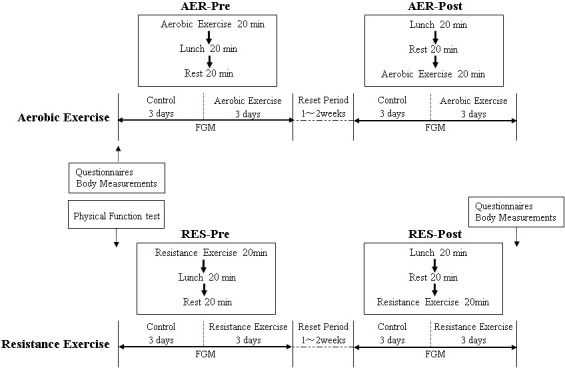
Study protocol. Each session included 3 days of control and 3 days of exercise. Each of the participants went through 4 sessions in total. In the first session, they performed aerobic exercise before lunch (AER‐Pre). In the second session, they performed aerobic exercise after lunch (AER‐Post). Following which, in the third session, exercise was changed to resistance exercise. RES‐Pre meant that participants had exercised before their lunch and RES‐Post shows exercise after lunch. The reset period was a period of time, in which participants were asked to have lunch and perform activities as usual, with no exercises during lunch breaks
During the 6 days, which included a 3‐day control period and a 3‐day exercise period, the participants’ diet during lunch was specified as follows: 100 g of rice (40 g of carbohydrate) as the main meal during lunch. And the participants were asked to continue their usual intake of proteins and fat. They were also asked to continue their usual breakfasts and suppers. Explanations to refrain from carbohydrate‐rich side dishes and snacks were provided to minimize their influence on glucose levels.
The control period comprised set lunches with no exercise. Furthermore, the reset period was a period of normal lunch and activity.
2.3. Exercise program
Figure 2 shows the exercise program implemented in this study. The program consisted of a 20‐minute moderate‐intensity exercise. For the aerobic exercise condition, participants walked at 6 km/h for 18 minute and 4 km/h for 1 minute each before and after lunch. Assuming that most of the participants did not habitually exercise, we set up exercises that could be performed safely and reliably. Walking speed was set at 4 km/h (3 METs) for warming up and 6 km/h (5 METs) during aerobic exercise. Prior to the study, the participants practiced walking 100 m in 90 s (4 km/h) and in 60 s (6 km/h) with the researcher. Next, they performed their routine warm ups and exercises, which included walking at 4 km/h and 6 km/h, respectively.
FIGURE 2.
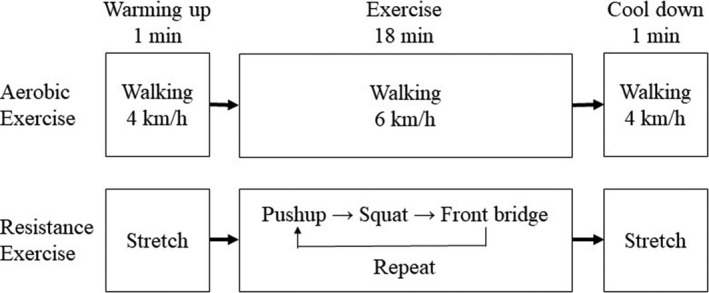
Exercise program. The program consisted of 20 minute of exercise, including warm‐up and cool‐down in the first and the last 1‐minute. Aerobic exercise included walking at 6 km/h, and the walking speed was calculated using duration and walking distance. Resistance exercises comprised 3 types of performances, the intensity of exercise was set to medium
With regard to the resistance exercises, the participants were instructed to repeat pushups, squats, and front bridges that required no equipment and were done in a corner of the workplace, using a mat. A physical function test was performed before the resistance exercise session began. This test measured the maximum number of push‐ups and squats that could be done in 30 seconds, and the length of time in seconds for which a front bridge position could be maintained. Based on these results, the number of individual exercises was set, and participants were asked to repeat these exercises for 18 minute at their own pace with 10‐ to 20‐second breaks. Stretches were performed for 1 minute for warm‐up and cool‐down before and after resistance exercises.
2.4. Measurements
Participants were asked to complete questionnaires about lifestyle and the stages of behavioral change related to exercise on the first and last days of the study. On the same day, weight, body fat percentage, muscle mass, basal metabolism, and body mass index (BMI) were measured using a body composition analyzer (DC‐320, TANITA Inc, Tokyo, Japan). Abdominal circumference was measured on a horizontal plane above the umbilicus.
Glucose levels were measured using the Flash Glucose Monitoring System (FGM) (Free Style Libre, ABBOTT Japan Inc, Chiba, Japan). The FGM automatically measures glucose levels in body fluids and records a representative value every 1 minute and every 15 minute. It was worn continuously for 6 days during the control and exercise periods.
The number of steps and the intensity of exercise during the exercise program were measured using a physical activity meter (Lifecorder® GS, SUZUKEN Inc, Nagoya, Japan). During the exercise program, mealtimes, dietary habits, exercise time, physical condition, and subjective exercise intensity, ie, rating of perceived exertion (RPE), were recorded.
2.5. Statistical analysis
Questionnaire responses were assessed using descriptive statistics. Moreover, exercise intensity, changes in glucose levels over time, and the IAUC were determined using the Wilcoxon signed‐rank test. The IAUC was calculated using the trapezoidal method. SPSS Advanced Statistics Version 26 (IBM Japan, Ltd.) was used for all analyses. A P value of <.05 was considered statistically significant.
3. RESULTS
3.1. Participant characteristics
Of the 15 participants, 4 were unable to complete the protocol. Thus, the final analysis included 11 participants; 2 of whom completed the aerobic exercise protocol alone. Table 1 shows the baseline characteristics of the included participants. Among them, 2 met the Ministry of Health, Labour, and Welfare's criteria for obesity I (BMI of 30‐35). After meals, glucose levels increased to 140 mg/dL or more in 5 participants. There was no significant difference in body composition at either the start or the end of the study period.
TABLE 1.
Characteristics of the subject
| n = 11 | ||
|---|---|---|
| Means ± SD | Range | |
| Age (y) | 42.7 ± 9.4 | 29‐58 |
| Gender (male/female) | 5/6 | |
| Occupation (teacher/office worker) | 8/3 | |
| Height (cm) | 164.8 ± 5.3 | 157.0‐174.0 |
| Body weight (kg) | 62.9 ± 10.9 | 45.8‐81.7 |
| Body fat (%) | 28.2 ± 8.5 | 19.1‐47.2 |
| Muscle mass (kg) | 42.2 ± 6.4 | 32.3‐54.4 |
| Basal metabolic rate (kcal) | 1,284 ± 168 | 1,013‐1,596 |
| Body mass index (kg/m2) | 23.1 ± 4.1 | 18.1‐31.2 |
| Waist circumference (cm) | 82.9 ± 10.5 | 64.8‐102.5 |
| Sitting time (hr/day) | 7.8 ± 0.5 | |
| Exercise at least once a week (yes/no) | 4/7 | |
| Resistance test† | ||
| Push up (times/30 sec) | 18.4 ± 5.6 | 10‐28 |
| Squat (times/30 sec) | 9.6 ± 2.4 | 6‐12 |
| Front bridge (sec) | 56.0 ± 40.8 | 20‐160 |
Data are n or mean ± SD.
Resistance test is the maximum number of time and holding time of the resistance exercise that participants can perform in 30 seconds. Based on this, 50% was done by resistance exercise.
3.2. Representative changes in glucose levels due to exercise
Due to individual differences in glucose levels, changes were expressed based on the value recorded before lunchtime. A representative example is shown in Figure 3, wherein Participant A (women, 50 years old, BMI = 31.2) and Participant B (men, 58 years old, BMI = 30.0) had similar BMI values. Participant A showed normal glucose metabolism, however, participant B showed impaired glucose tolerance. As a result, Participant A showed a slower increase in blood glucose, whereas Participant B showed a significant increase. Although the cases had different trends, when observing IAUC (mg/dL, 120‐minute) from the start to the 120‐minute mark, both showed a decrease in postprandial glucose levels at AER‐Post (IAUC Participant A: Control 2034, AER‐Pre 2325, AER‐Post 792, RES‐Pre 1688, RES‐Post 1340; Participant B: Control 6209, AER‐Pre 3908, AER‐Post 3330, RES‐Pre 7028, RES‐Post 3357).
FIGURE 3.
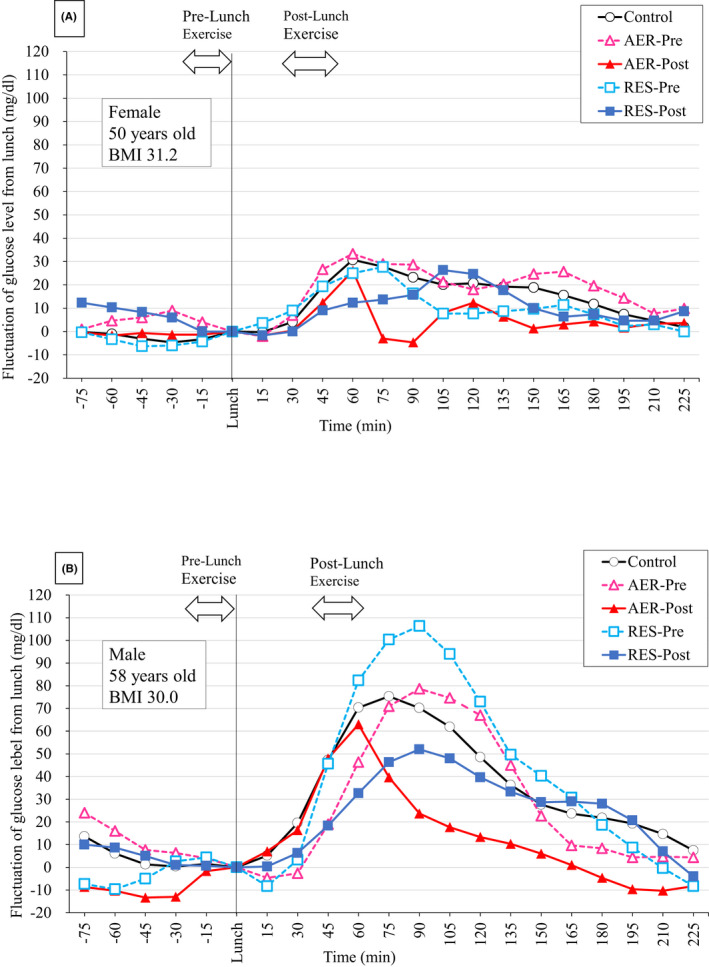
Representative changes in glucose levels due to exercise. An example of 2 representative participants who revealed the effect of exercise on postprandial blood glucose levels
3.3. Comparison of glucose levels over time based on the type of exercise
Figure 4 shows exercise‐induced changes in glucose levels over time. Glucose levels in AER‐Pre significantly decreased after the end of exercise, with the highest values being significantly lower (start of lunch: Control 84 ± 11, AER‐Pre 78 ± 13, P < .01; 60‐minute later: Control 131 ± 28, AER‐Pre 117 ± 23, P < .05; 75‐minute later: Control 132 ± 36, AER‐Pre 116 ± 28, P < .05; 135‐minute later: Control 109 ± 27, AER‐Pre 100 ± 19, P < .05; 150‐minute later: Control 104 ± 24, AER‐Pre 95 ± 17, P < .05). AER‐Post significantly lowered glucose levels after lunch from the 60‐minute mark to the 120‐minute mark. The data are as follows: 60‐minute later: Control 134 ± 32, AER‐Post 118 ± 26, P < .01; 75‐minute later: Control 133 ± 35, AER‐Post 104 ± 25, P < .01; 90‐minute later: Control 126 ± 32, AER‐Post 102 ± 20, P < .01; 105‐minute later: Control 120 ± 29, AER‐Post 107 ± 18, P < .01; 120‐minute later: Control 115 ± 26, AER‐Post 106 ± 16, P < .05. A significant increase was identified 15 minute after RES‐Pre (Control: 84 ± 15, AER‐Post: 90 ± 15, P < .05). In contrast, RES‐Post showed no significant changes at any point of time.
FIGURE 4.
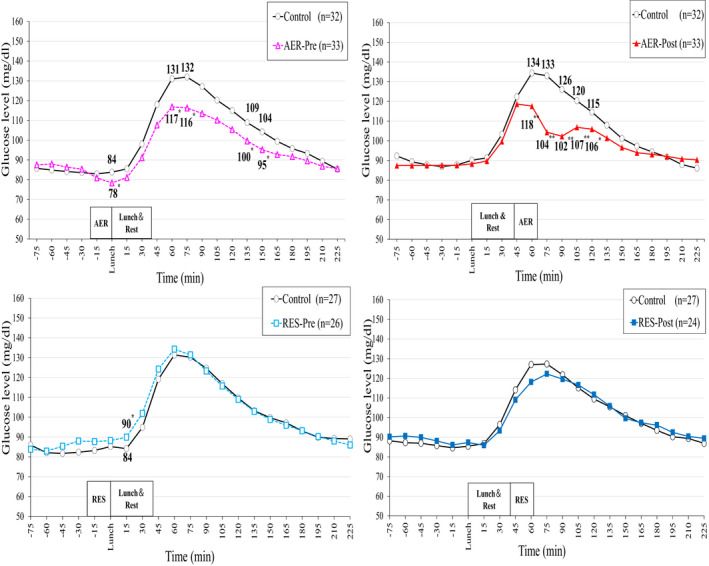
Comparison of glucose levels over time based on the type of exercise. The comparison of the values of control and each exercise over time. The 15‐minute interval is the time of recording FGM. Wilcoxon signed‐link test. *P < .05, **P < .01
Figure 5 shows the IAUC (mg/dL, 120‐minute) for measurements obtained 120‐minute after lunch. AER‐Post significantly reduced IAUC when compared to the control condition (Control: 3393 ± 1781; AER‐Post: 2143 ± 1245, P < .01).
FIGURE 5.
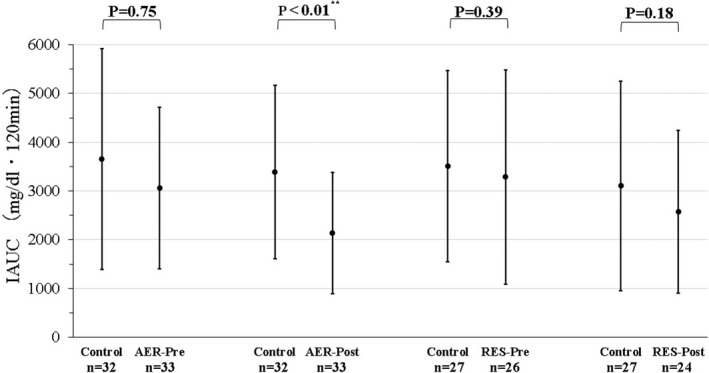
Decrease in IAUC due to exercise. The IAUC from the start of lunch to 120‐minute later: IAUC was calculated using the trapezoidal method for comparison. Wilcoxon signed‐link test. IAUC, incremental area under the curve. **P < .01
4. DISCUSSION
Previous studies have reported that aerobic exercise after a meal improves postprandial blood glucose levels and IAUC values. 10 , 20 The Japanese Ministry of Health, Labour, and Welfare recommends aerobic exercise 60‐120 minute after a meal to attenuate postprandial hyperglycemia. 21 However, lunch breaks typically range from 45 to 60 minute, which makes it difficult for general workers to exercise 60 minute after lunch. In addition, exercising immediately after a meal hinders digestion and absorption. In this study, we fixed the timings of eating lunch at 20 minute and resting at 20 minute for proper and uninterrupted digestion. Furthermore, aerobic or resistance exercises were performed before lunch or after lunch and a rest period.
AER‐Post was found to be the most effective pattern. AER‐Post continuously lowered blood glucose levels during times of elevated levels. As a result, IAUC was the lowest during AER‐Post among the 4 patterns. Previous studies have also reported similar results. 9 , 10 With regard to exercise intensity and duration, previous studies have shown that a higher intensity of exercise is more effective, and exercises of lower intensities have to be performed for longer periods of time. 12 , 13 However, the present study revealed different results, in which 20 minute of moderate‐intensity (5 METs) exercise showed an acute reduction in postprandial blood glucose levels. The second most effective was AER‐Pre. Prior research has shown that a pre‐meal exercise is effective in lowering blood sugar levels. 22 Pre‐meal aerobic exercise activates AMP‐activated protein kinase (AMPK) that leads to the translocation of glucose transporter 4 (GLUT4) to the surface of skeletal muscle cells. 23 Uptake of blood glucose into skeletal muscle cells through AMPK/GLUT4 pathway is thought to inhibit the increase in postprandial blood glucose.
Moreover, although a decrease in the IAUC comparison is apparent, RES‐Post is not significantly different. This result may have been influenced by the small number of subjects included in the study. Furthermore, the RES‐Pre condition exerted no acute effect on blood glucose levels.
Our findings suggest that, if given a 60‐minute lunch break, workers may benefit from a 20‐minute aerobic exercise (walking at 6 km/h) after lunch and a rest period of 20 minute. The ideal time to exercise would be 60 or 90 minute following a meal for uninterrupted digestion; however, it is not feasible for workers with a lunch break of 60 minute. Aerobic exercise after lunch (AER‐Post) would be the most feasible measure for reducing postprandial glucose levels. Moreover, AER‐Pre was also effective for lowering blood glucose levels. It is therefore possible for workers with short lunch breaks of 45 minute to achieve blood glucose control by performing 20‐minute aerobic exercises before lunch.
Previous research has indicated that the risk of developing diabetes in the working people is related to the amount of exercises at leisure, rather than the amount of physical activity during work or commute. 24 However, we speculate that incorporating aerobic exercises into lunch breaks can attenuate postprandial increases in blood glucose levels even among workers who do not engage in leisurely exercises. This may in turn reduce insulin secretion and the risk of developing diabetes. Therefore, 20‐minute exercises performed during lunch breaks during the 40 years of working life will lead to the prevention of diabetes, atherosclerosis, and cardiovascular diseases.
The strength of this study is that aerobic and resistance exercises were performed before and after lunch by the same participants. We were able to determine that aerobic exercise after lunch (AER‐post) is the best pattern for workers with lunch breaks of 60 minute and aerobic exercise before lunch (AER‐pre) is recommended for workers with lunch breaks of 45 minute.
There are certain limitations in this study. First, there are differences between the results of FGM and blood glucose levels. Although the differences between FGM and blood glucose exist, we assessed a change in glucose levels so that it would not affect this study. Second, diabetic conditions, such as 75 g OGTT and HbA1c of participants, were not taken into consideration because these participants were recruited in a work setting as opposed to clinical settings. The body type of the subjects ranged from underweight to obese, forming an ideal occupational health setting. Usually, exercise therapy for obese subjects is aimed at reducing body weight, for which a mild‐intensity aerobic exercise performed for a longer duration is strongly recommended. However, it is also emphasized that certain Japanese populations show glucose intolerance even though they are not obese. Therefore, it is important to recommend and encourage exercising among all workers regardless of their body type. Moreover, the main purpose of this study was to explore a means of preventing diabetes; therefore, it is crucial to emphasize starting exercise during lunch breaks for young individuals with a normal body weight. Third, only 11 sedentary workers were included in this study. It is necessary to investigate this in a larger study population, including blue‐collar workers. Resistance exercise, which did not show any significant effect on the participants of this study, needs to be verified using a larger number of participants. In addition, we believe that validating the effects of a combination of aerobic and resistance exercise is an additional issue of this study.
5. CONCLUSION
Our analysis indicated that the AER‐Post condition displayed the most significant effect in lowering postprandial glucose levels, followed by the AER‐Pre pattern. Thus, workers with 60‐minute lunch breaks may benefit from a 20‐minute aerobic exercise routine performed after lunch and a rest period of 20 minute as this may help to prevent progression toward diabetes. It is recommended for workers with 45‐minute lunch breaks to perform 20 minute of aerobic exercise prior to lunch (AER‐pre), as it can also attenuate postprandial increases in blood glucose levels. From an occupational health perspective, it is necessary to inculcate exercise programs and interventions for all workers during lunch breaks, as it may prevent diabetes and cardiovascular complications in the future.
DISCLOSURE
Approval of the research protocol: The present study was approved by the Ethics Committee of the University of Occupational and Environmental Health (No. H30‐064). Informed Consent: Participants were informed via verbal and written communication outlining the objectives of the study, the requirements for withdrawal, and the freedom to decline participation with no further disadvantages. Voluntary consent was obtained from each participant. Registry and the Registration No. of the study/Trial: N/A. Animal studies: N/A. Conflict of Interest: The authors declare no other conflicts of interest for this article.
AUTHOR CONTRIBUTIONS
NY, Y.H, and JY contributed to the following: conception of the idea, data collection and analysis, and manuscript writing.
ACKNOWLEDGMENTS
The funding source had no role in the design, practice or analysis of this study.
Yoko N, Hiroshi Y, Ying J. Type and timing of exercise during lunch breaks for suppressing postprandial increases in blood glucose levels in workers. J Occup Health. 2021;63:e12199 10.1002/1348-9585.12199
REFERENCES
- 1. Ministry of Health, Labour, and Welfare . Overview of the 2017 patient survey. Estimated number of cases. https://www.mhlw.go.jp/toukei/itiran/#anc2‐3. Accessed September 2, 2020. (in Japanese).
- 2. Ministry of Health, Labour, and Welfare . White paper on health, labor, and welfare. 2018. https://www.mhlw.go.jp/stf/wp/hakusyo/kousei/18/backdata/01‐01‐02‐08.html. Accessed September 30, 2020. (in Japanese).
- 3. Japan Sports Agency . The root of opinion poll on the implementation status of sports in the2019. https://www.mext.go.jp/sports/b_menu/toukei/chousa04/sports/1415963_00001.htm. Accessed September 2, 2020. (in Japanese).
- 4. Ministry of Health . National Health and Nutrition Examination Part 4 Annual Results. 2017. https://www.mhlw.go.jp/content/10900000/000635990.pdf. Accessed September 2, 2020. (in Japanese).
- 5. Ceriello A. The post‐prandial state and cardiovascular disease: relevance to diabetes mellitus. Diabetes Metab Res Rev. 2000;16:125‐132. [DOI] [PubMed] [Google Scholar]
- 6. Bacchi E, Negri C, Zanolin ME, et al. Metabolic effects of aerobic training and resistance training in type 2 diabetic subjects. Diabetes Care. 2012;35:676‐682. [DOI] [PMC free article] [PubMed] [Google Scholar]
- 7. Schwingshackl L, Missbach B, Dias S, Köing J, Hoffmann G. Impact of different training modalities on glycaemic control and blood lipids in patients with type 2 diabetes: a systematic review and network meta‐analysis. Diabetologia. 2014;57:1789‐1797. [DOI] [PubMed] [Google Scholar]
- 8. Umpierre D, Ribeiro PAB, Schaan BD, Ribeiro JP. Volume of supervised exercise training impacts glycaemic control in patients with type 2 diabetes: a systematic review with meta‐regression analysis. Diabetologia. 2012;56:242‐251. [DOI] [PubMed] [Google Scholar]
- 9. Shri R, Zarrabi L, Bennington L, et al. Postprandial walking is better for lowering the glycemic effect of dinner than pre‐dinner exercise in type 2 diabetic individuals. J Post‐Acute Long‐Term Care Med. 2009;10:394‐397. [DOI] [PubMed] [Google Scholar]
- 10. Borror A, Zieff G, Battaglini C, Stoner L. The effects of postprandial exercise on glucose control in individuals with type 2 diabetes: a systematic review. Sports Med. 2018;48:1479‐1491. [DOI] [PubMed] [Google Scholar]
- 11. Hatomoto Y, Goya R, Yamada Y, et al. Effect of exercise timing on elevated postprandial glucose levels. J Appl Physiol. 2016;123:278‐284. [DOI] [PubMed] [Google Scholar]
- 12. Haxhi J, Palumbo AS, Sacchetti M. Exercising for metabolic control: is timing important? Ann Nutr Metab. 2013;62:14‐25. [DOI] [PubMed] [Google Scholar]
- 13. Nyggard H, Tomten SE, Høstmark AT. Slow postmeal walking reduces postprandial glycemia in middle‐aged women. Appl Physiol Nutr Metab. 2009;34:1087‐1092. [DOI] [PubMed] [Google Scholar]
- 14. Snowling NJ, Hopkins WG. Effects of different modes of exercise training on glucose control and risk factors for complications in type 2 diabetic patients: a meta‐analysis. Diabetes Care. 2006;29:2518‐2527. [DOI] [PubMed] [Google Scholar]
- 15. Eikenberg DJ, Savla J, Marinik EJ, et al. Prediabetes phenotype influences improvements in glucose homeostasis with resistance training. PLoS One. 2016;11:1‐13. [DOI] [PMC free article] [PubMed] [Google Scholar]
- 16. Russell RD, Nelson AG, Kraemer RR. Short bouts of high‐intensity resistance‐style training produce similar reductions in fasting blood glucose of diabetic offspring and controls. J Strength Cond Res. 2014;28:2760‐2767. [DOI] [PubMed] [Google Scholar]
- 17. JungHoon J, DoHoun K, Changkeun K. Resistance training for glycemic control, muscular strength, and lean body mass in old type 2 diabetic patients: a meta‐analysis. Diabetes Ther. 2017;8:459‐473. [DOI] [PMC free article] [PubMed] [Google Scholar]
- 18. Sianoja M, Syrek CJ, Bloom J, Korpela K, Kinnunen U. Enhancing daily well‐being at work through lunchtime park walks and relaxation exercises: recovery experiences as mediators. J Occup Health Psychol. 2018;23:428‐442. [DOI] [PubMed] [Google Scholar]
- 19. Michishita R, Jiang Y, Ariyoshi D, Yoshida M, Moriyama H, Yamato H. The practice of active rest by workplace units improves personal relationships, mental health, and physical activity among workers. J Occup Health. 2017;59:122‐130. [DOI] [PMC free article] [PubMed] [Google Scholar]
- 20. Reynolds AN, Mann JI, Williams S, Venn BJ. Advice to walk after meals is more effective for lowering postprandial glycaemia in type 2 diabetes mellitus than advice that does not specify timing: a randomised crossover study. Diabetologia. 2016;59:2572‐2578. [DOI] [PubMed] [Google Scholar]
- 21. Iemitu M.Exercise to improve diabetes. Ministry of Health, Labour, and Welfare. e‐health‐net, Physical activity exercise. https://www.e‐healthnet.mhlw.go.jp/information/exercise/s‐05‐005.html. Accessed September 3, 2020. (in Japanese).
- 22. Monique E, Francois JC, Baldi PJ, et al. ‘Exercise snacks’ before meals: a novel strategy to improve glycaemic control in individuals with insulin resistance. Diabetologia. 2014;57:1437‐1445. [DOI] [PubMed] [Google Scholar]
- 23. Hayashi T, Wojtaszewski JFP, Goodyear LJ. Exercise regulation of glucose transport in skeletal muscle. Am Physiol Soc. 1997;273:E1039‐1051. [DOI] [PubMed] [Google Scholar]
- 24. Honda T, Kuwahara K, Nakagawa T, Yamamoto S, Hayashi T, Mizoue T. Leisure‐time, occupational, and commuting physical activity and risk of type 2 diabetes in Japanese workers: a cohort‐study. BMC Public Health. 2015;15:1004. [DOI] [PMC free article] [PubMed] [Google Scholar]


